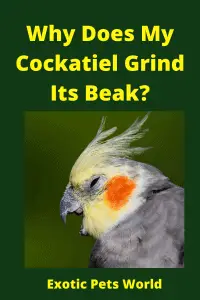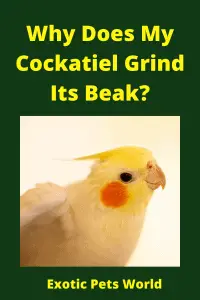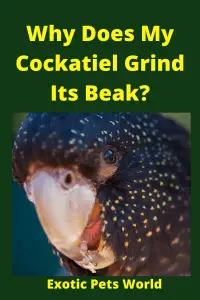Cockatiel Beak Grinding / Why Its Beak?
Why Does My Cockatiel Grind Its Beak? Do you ever hear any grinding sounds coming from your cockatiel’s cage? If you do, don’t be alarmed. It’s your bird grinding its beak, and this behavior is perfectly normal.
No one is sure why parrots such as cockatiel grind their beaks, but they usually do this to calm themselves, especially before going to bed. Grinding the beak reflects a state of relaxation and calmness. Most cockatiels grind their beaks before bed or when they are resting on a perch. The sound of beak grinding is also a sign that your cockatiel is happy and relaxed.
There are many reasons why parrots grind their beaks, but they usually grind more often just before they roost. Typically, they’ll sit on their bird’s perches, hold open one of their legs, and then you’ll hear them grind their beaks. Cockatiel Beak Grinding / Why Its Beak?
Cockatiel grinding beaks is not the same as grinding teeth in humans, which indicates anxiety and stress. However, grinding should not be excessive; otherwise, it leads to bad habits and, in severe cases, may lead to medical conditions.
Birds usually chew on their cage bars or exhibit other destructive behaviors under pressure. But if you notice that your cockatiel is grinding its beak during periods other than before going to bed or the grinding continues for a long time, or you feel any damage to their beak, talk to your avian veterinarian. To help redirect this type of behavior, provide your birds with safe chew and feeding toys.
Some people believe that grinding has something to do with beak trimming, but there is no evidence to verify this assumption. So, if you hear that your bird is grinding its beak before nap or before going to sleep, you can be assured that your bird is comfortable.
Why Does My Cockatiel Grind its Beak / Do Cockatiels Need to Trim Their Beaks?
Most parrots, cockatiels, and other birds trim their beaks by chewing and playing. However, some bird’s beaks may overgrow due to malnutrition, illness, or lack of proper toys. Therefore, they need to be trimmed from time to time.
Never trim your bird’s beak by yourself, as this can cause significant pain to your bird. Instead, look for a professional vet who specializes in birds, can make the beak’s trimming process painless.

Why Does My Cockatiel Grind Its Beak_
How to Trim a Cockatiels Beak?
A cockatiel uses its beak for many activities, including grooming its wings, shelling seeds, and protecting itself from other birds. Like a human jaw structure, a cockatiel’s beak is composed of a lower mandible and upper maxilla. The cockatiel beak’s tip is similar to human nails because it has no nerves and is not sensitive.
The only part of the beak closest to the cockatiel has a maximum number of nerves and blood supply. A healthy and fit cockatiel beak should be smooth, with no deformities or cracks, and of appropriate length. You may need to trim your cockatiel beak in rare cases to maintain its proper size and shape.
Procedure:
Step 1
Attach the conditioning perch to the inside of your cockatiel cage. They are usually made of concrete or clay. Your cockatiel will use this clay or concrete perch to trim its beak and nails. Replace the conditioning perch when it’s worn out
Step 2
Put a cuttlebone in front of the perch on one side of the cockatiel cage. Cockatiels will be peck on the cuttlebone and will gently trim their beaks to the appropriate size.
Step 3
Arrange different sizes of avian toys in your cockatiel cage. Cockatiels enjoy toys with plastic beads, ropes, coconut pieces, and wooden blocks. Your bird will chew the toy, and you grind its beak. Be sure to change the toys to prevent your pet’s cockatiel from getting bored or stressed out.
Step 4
Use a Dremel tool carefully to remove excess beak growth. First, consult your avian vet to determine the proper length and shape of your cockatiel’s beak. Wrap your cockatiel gently in a towel to restrain it in one place. Attach a diamond girt cutting disc small or carborundum stone to the grinder. Carefully grind the tip of the beak to its full length. If bleeding is present, apply the sticky powder on the beak.

Why Does My Cockatiel Grind Its Beak_
Is Beak Grinding Normal? Or Not.
Don’t worry; beak grinding is a natural phenomenon. Cockatiels grind their beaks as a sign of calm and serenity along with peace and relaxation. They do this after being busy during the day and decide that chill out afterward.
Beak grinding is usually a sign of contentment in Cockatiels, and they often do this when they fall asleep. They did beak grinding by sliding a beak from one side to the other. Some experts believe that birds keep their beaks in perfect condition by grinding them.
How to help a Bird with a Broken Beak?
Provide Immediate Care
If the beak is cracked, torn off, or its outer layers are damaged, the underlying tissues may begin to dry out. Always clean the wound with saline (a preservative-free solution is best for such conditions) to help remove any debris and keep the tissue moist as long as your vet comes and checks it. Do not do violent or harsh flushing. Also, do not remove the beak if it is partially attached.
Your doctor may trim your bird’s beak or wire it together. In the hospital, the bird may need a feeding tube until the beak grows back, and when the beak grows again, your bird will need moist and soft food.
Long Term Care and Management:
With a minor beak injury, appropriate antimicrobials, supportive care, and pain medication, and time needed for healing may all be necessary until the beak injury removes completely. With more extensive beak damages, dental acrylics or light-cured composites can patch the area until the beak grows.
If the blood supply is still sufficient, beak fracture can be repaired. Some beak injuries result in irreversible and permanent damage, which requires the bird to eat soft and moist food for the rest of its life, but other wounds can heal well, allowing the bird to recover or regrow to normal beaks with the proper functioning
Will any Cracked Beak Heal on its Own?
Below is a collection of recommendations and inputs given by breeders, bird owners, and avian vets about cracked beaks.
- A cracked/torn beak is like a broken tooth, and since the beak is connected to bones and nerve endings, such injuries are quite painful for birds.
- A cracked/broken beak does not grow all at once but grows over time.
- Torn off, fractured beaks or amputated beaks will not grow back but can be repaired.
- The bird’s beak has a plentiful blood supply, so there is a risk of excessive bleeding too. With a fracture, puncture, or amputated beak, you must apply pressure to stop the bleeding. You must contact an emergency vet clinic or your avian vet as soon as possible, but don’t wait more than a day (24 hours)!

Why Does My Cockatiel Grind Its Beak_
Common Beak Health Problems
Malnutrition:
Excess fat in the diet and poor nutrition can lead to liver disease and overgrown scaly beaks. Lack of vitamin D and calcium can lead to ribbed and soft, beaks mostly in small birds such as cockatiels. The solution is straight and simple: keep the birds on proper nutrition and diet, and over time, these symptoms can usually be cured.
Trauma
Birds can injure their beaks due to fighting between other birds. Some possible causes of trauma to beaks are:
- Chewing on electric cords
- Falling on a hard floor
- Fly into windows or ceiling fans, and their beaks get struck between the cage bars.
All these injuries can result in a beak fracture, puncture wound, or avulsions (the beak is complete or partially ruptured). Beak injuries are almost always emergencies that require immediate attention from a professional avian veterinarian.
Abnormal Beak Growth and Development:
Some young birds have beak abnormalities. These may include:
- Overgrown beak, where the upper or lower beak is too long.
- Scissor beak, which is the lateral deviation of the lower and upper beaks
- Mandibular prognathism is also known as parrot underbite. This may be due to genetics and malnutrition during development. These conditions are generally fixed with dental equipment, which works the same as human braces to align the beak.
Cancer:
Birds’ beaks may be affected by cancer, mainly melanoma, and squamous cell carcinoma. This can lead to beak erosion, beak discoloration, and the appearance of masses on the beak. If diagnosed early, beak tumors may be removed surgically.
Infectious Diseases:
Many parasitic, bacterial, viral, and fungal pathogens can directly affect birds’ beaks or other parts of the bird’s body, causing secondary discomfort and problems to beaks.
Some of the most familiar infectious diseases of birds include face mites, scaly leg, avian pox, and psittacine beak and feather disease (PBFD). Fungal and bacterial infections are usually treated with antifungal or antibiotics drugs.
If you notice something strange about your bird’s beak, contact your avian vet immediately. The sooner you solve this problem, the sooner your birds will recover.

Why Does My Cockatiel Grind Its Beak_
Signs of a Healthy Beak
A healthy cockatiel has a healthy beak. These are the signs which show your bird’s beak is healthy:
- Proper alignment of upper-lower beak
- There are discolored spots/areas
- There is no peeling or weird texture
- Smooth, even appearance
- Appropriate beak length (check with avian doctor)
Conclusion:
The beak is one of the sensitive parts of parrots and other birds. Proper beak health is essential for birds because of the use of their beaks for feeding and grooming. If any severe beak injury occurs, rush to the nearby avian vet clinic, do not do something on your own. Otherwise, you will cause more damage and to your bird’s beak instead of curing it.
Beak grinding sound produced by birds, especially cockatiels, are normal phenomena, and birds make these sounds when they are happy or going to sleep.
